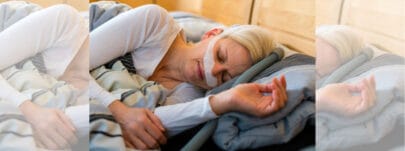
How Does CPAP Improve Oxygenation in Sleep Apnea Patients
Obstructive sleep apnea (OSA) is caused by a blockage of the upper airways when the muscles in the throat relax while you sleep. This results in breathing difficulties that can see you briefly wake hundreds of times through the night, sometimes gasping for air. Each breathing pause sees a drop in oxygen levels.
CPAP or PAP therapy are leading treatments for OSA, delivering pressurized air through a mask worn when sleeping. The air keeps your airways free from obstruction to prevent pauses in your breathing. In keeping the airways open, how does PAP therapy improve oxygenation?
Obstructive Sleep Apnea and Hypoxemia
Hypoxemia is the term given to low oxygen levels in the blood and can be a serious health issue. This may result in issues with the heart, lungs and brain, as well as worsen any underlying conditions.
Someone with severe OSA can have their sleep disturbed over 30 times every hour. Even a moderate degree of the disorder can see you wake for air between 15 to 30 times every hour.
Although these awakenings are usually brief and are often only first noticed by a bed partner, they result in hypoxemia.
While oxygen levels do return to normal, the frequency of the pauses to breathing means you are often in a state of hypoxemia throughout the night when OSA remains undiagnosed and left without treatment.
The symptoms of OSA include:
- frequently awakening for air
- snoring
- excessive daytime fatigue
- dry mouth in the morning
- morning headaches
- irritability
- poor concentration
If you or your bed partner recognizes these symptoms you should consult your health provider who can arrange a sleep study if they suspect OSA. Once diagnosed, OSA can be treated, allowing you improved sleep and reducing the risk of the serious health conditions linked to OSA including heart disease, stroke and diabetes.
How Does PAP Therapy Improve Oxygenation?
PAP stands for positive airway pressure therapy; CPAP provides continuous pressurized air. This therapy involves a device to deliver a stream of air that is pressurized to a setting to prevent the blockage of your airways. The air is delivered along a tube to a mask worn overnight.
In keeping the airways open, PAP reduces the number of breathing pauses experienced and therefore reduces the number of occasions you need to wake for air. You should notice a drop in your snoring and find you don’t feel so fatigued in the morning because you are receiving better quality sleep.
PAP also improves oxygenation by the sheer fact that it keeps the airways free from obstruction and allows a constant flow of air into the lungs. Without any obstruction of air to the lungs, PAP prevents hypoxemia and reduces the risk of the health issues linked to this condition.
Your health provider will work with you to provide a PAP device and mask that works best for you. A properly fitting mask is essential for effective treatment as it helps create a tight seal to prevent any leakage of the pressurized air. This means all the air is directed where it is needed to keep the airways free from obstruction.
Do You Need an Oxygen Concentrator Too?
A health provider might consider the need for supplemental oxygen for someone with OSA to help improve oxygenation. This can involve a concentrator that removes the nitrogen from the air before its delivery.
However, while supplemental oxygen levels can benefit the treatment of hypoxemia, it does not address the symptoms of OSA as it won’t keep your airways free from obstruction.
Therefore, its impact on how many times you wake for air will be negligible. Your blood-oxygen levels will improve but you will still feel drowsy during the day and any snoring issues will continue (much to a bed partner’s dismay!).
PAP Delivers on Both Points
PAP helps improve oxygenation and also removes your sleep apnea symptoms. It does this by delivering pressurized air that allows the flow of oxygen into the lungs. If there was a scenario where your health provider thought you required further oxygenation, then the use of an oxygen concentrator may be recommended.
Final Thoughts
PAP and CPAP are effective treatments for obstructive sleep apnea. By keeping the airways open, both improve your sleep and resolves the sleep deprivation that can increase your risk of serious health complications.
Low blood-oxygen levels result from the breathing pauses caused by obstructive sleep apnea. However, the pressurized air delivered by PAP therapy helps prevent the airways from collapsing, allowing a continuous flow of air to the lungs. This can restore blood-oxygen levels without the need for additional means of supplemental oxygenation.



